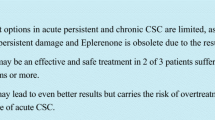Abstract
Purpose
To investigate the effect of oral Rifampin in patients with chronic central serous chorioretinoapthy (CSCR).
Methods
This was a prospective pilot study of patients with chronic CSCR with persistent subretinal fluid (SRF) for at least 3 months, who were treated with oral Rifampin 300 mg twice per day for 3 months and had 6 months of follow-up. All patients underwent a complete ocular examination and a spectral domain optical coherence tomography (SD-OCT) scan monthly from baseline until month 4, and then at month 6. Fluorescein angiography (FA) was performed at baseline and at the end of the study.
Results
Fourteen eyes of 12 patients were included in the study, nine men and three women. Mean age was 58.5 years (range 32–80). Mean duration of SRF prior to study entry was 28.4 months. Forty-two percent of eyes were treated previously for CSR with thermal laser, PDT, or intravitreal bevacizumab. Mean best corrected visual acuity (BCVA) at presentation was 20/60 and improved to a mean of 20/50 at month 3 (P > 0.05). Retinal thickness was reduced by 25.3 %, 21.2 %, and 21 % on months 1, 2, 3, respectively (P < 0.05). Mean choroidal thickness at presentation was 476 μ (SD 188 μ) decreasing to 427 μ (SD 125 μ) after 3 months of treatment (P > 0.05). SRF was reduced in nine eyes (64 %) and completely resolved in six eyes (42.8 %) at month 3 following 3 months of treatment, and four out of these six eyes remained fluid free at month 6. Two patients stopped the treatment after 2 months due to adverse events.
Conclusions
Oral Rifampin may be a therapeutic option in patients with longstanding chronic CSCR.






Similar content being viewed by others
References
Gass JD (1967) Pathogenesis of disciform detachment of neuroepithelium: II. Idiopathic central serous choroidopathy. Am J Ophthalmol 63:587–615
Levine R, Brucker AJ, Robinson F (1989) Long-term follow-up of idiopathic central serous chorioretinopathy by fluorescein angiography. Ophthalmology 96:854–859
Loo RH, Scott IU, Flynn HW Jr et al (2002) Factors associated with reduced visual acuity during long-term follow-up of patients with idiopathic central serous chorioretinopathy. Retina 22:19–24
Imamura Y, Fujiwara T, Margolis R, Spaide RF (2009) Enhanced depth imaging optical coherence tomography of the choroid in central serous chorioretinopathy. Retina 29:1469–1473
Jampol LM, Weinreb R, Yanuzzi LA (2002) Involvement of corticosteroids and catecholmines in the pathogenesis of central serous chorioretinopathy : a rational for new treatment strategies. Ophthalmology 109:1765–1766
Nicholson B, Noble J, Forooghian F, Meyerle C (2013) Central serous chorioretinopathy: update on pathophysiology and treatment. Surv Ophthalmol 58:103–26
Bousquet E, Beydoun T, Zhao M et al (2013) Mineralocorticoid receptor antagonism in the treatment of chronic central serouschorioretinopathy: a pilot study. Retina 33:2096–102
Silva RM, Ruiz-Moreno JM, Gomez-Ulla F et al (2013) Photodynamic therapy for chronic central serous chorioretinopathy: a 4-year Follow-up study. Retina 33:309–315
Reibaldi M, Cardascia N, Longo A et al (2010) Standard-fluence versus low-fluence photodynamic therapy in chronic central serous chorioretinopathy: a nonrandomized clinical trial. Am J Ophthalmol 149:307–315
Ruiz-Moreno JM, Lugo FL, Armadá F et al (2010) Photodynamic therapy for chronic central serous chorioretinopathy. Acta Ophthalmol 88:371–376
Lim SH, Chang W, Sagong M (2013) Efficacy of half fluence photodynamic therapy depending on the degree of choroidal hyperpermeability in chronic central serous chorioretinopathy. Eye (Lond) 27:353–362
Smretschnig E, Ansari-Shahrezaei S, Hagen S et al (2013) Half-fluence photodynamic therapy in chronic central serous chrioretinopathy. Retina 33:316–323
Inoue R, Sawa M, Tsujikawa M, Gomi F (2010) Association between the efficacy of photodynamic therapy and Indocyenine green angiography finding for central serous chorioretinopathy. Am J Ophthalmol 149:441–446
Bae SH, Heo J, Kim C et al (2014) Low-fluence photodynamic therapy versus Ranibizumab for chronic Central serous Chorioretinopathy: One-year results of a randomized trial. Ophthalmology 121:558–65
Meyerle C, Bailey Freund K et al (2007) Ketoconazole in the treatment of chronic idiopathic central serous chorioretinopathy. Retina 27:943–946
Nielsen JS, Weinreb RN, Yannuzzi L, Jampol LM (2007) Mifepristone treatment of chronic central serous chorioretinopathy. Retina 27:119–22
Nielsen JS, Jampol LM (2011) Oral mifepristone for chronic central serous chorioretinopathy. Retina 31:1928–36
Kurup SK, Oliver A, Emanuelli A et al (2012) Low-dose methotrexate for the treatment of chronic central serous chorioretinopathy: a retrospective analysis. Retina 32:2096–101
Masayoshi S, Nozomi F, Yutaka K (2009) Rifampicin as an Oral Angiogenesis Inhibitor Targeting Hepatic Cancers. Cancer Res 69:4760–8
Guengerich FP (1999) Cytochrome P-450 3A4: regulation and role in drug metabolism. Annu Rev Pharmacol Toxicol 39:1–17
Steinle NC, Gupta N, Yuan A, Singh RP (2012) Oral rifampin utilisation for the treatment of chronic multifocal central serous retinopathy. Br J Ophthalmol 96:10–3
Spaide RF, Koizumi H, Pozonni MC (2008) Enhanced depth imaging spectral domain optical coherence tomography. Am J Ophthalmol 146:496–500
Margolis R, Spaide RF (2009) A pilot study of enhanced depth imaging optical coherence tomography of the choroid in normal eyes. Am J Ophthalmol 147:811–815
Mårde Arrhén Y, Nylén H, Lövgren-Sandblom A et al (2013) A comparison of 4β-hydroxycholesterol : cholesterol and 6β- hydroxycortisol: cortisol as markers of CYP3A4 induction. Br J Clin Pharmacol 75:1536–40
Keven K, Uysal AR, Erdogan G (1998) Adrenal function during tuberculous infection and effects of antituberculosis treatment on endogenous andexogenous steroids. Int J Tuberc Lung Dis 2:419–24
Wang M, Munch IC, Hasler PW et al (2008) Central serous chorioretinopathy. Acta Ophthalmol 86:126–45
Chikaraishi Y, Matsunaga N, Shimazawa M, Hara H (2008) Rifampicin inhibits the retinal neovascularization in vitro and in vivo. Exp Eye Res 86:131–137
http://www.pdr.net/drug-summary/rifadin?druglabelid=1036&id=2531 (Accessed 10 Jan 2015).
Pikuleva IA (2006) Cytochrome P450s and cholesterol omeostasis. Pharmacol Ther 112:761–73
Author information
Authors and Affiliations
Corresponding author
Additional information
This paper was presented in part in the American Academy of Ophthalmology meeting, New Orleans, LA, USA, November 2013.
Rights and permissions
About this article
Cite this article
Shulman, S., Goldenberg, D., Schwartz, R. et al. Oral Rifampin treatment for longstanding chronic central serous chorioretinopathy. Graefes Arch Clin Exp Ophthalmol 254, 15–22 (2016). https://doi.org/10.1007/s00417-015-2989-z
Received:
Revised:
Accepted:
Published:
Issue Date:
DOI: https://doi.org/10.1007/s00417-015-2989-z




